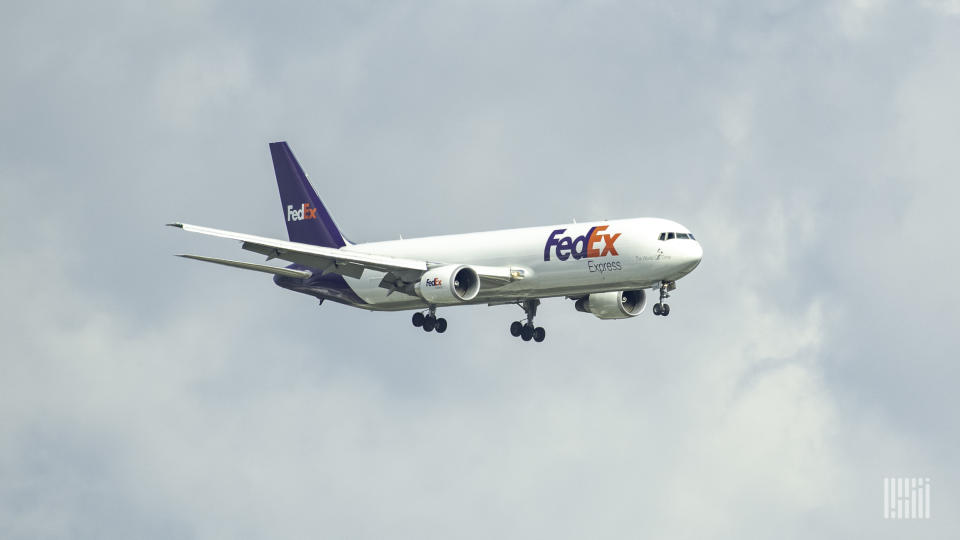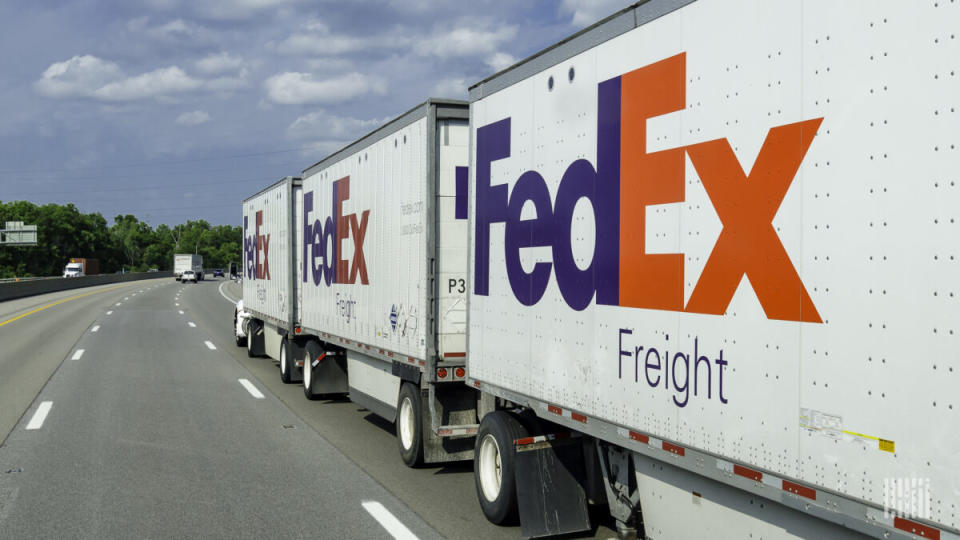FedEx deactivates 17 more aircraft as cost controls pay off

FedEx has parked 17 more freighter aircraft since November and relinquished options to buy seven Boeing 767 cargo jets, part of a multiyear cost initiative that helped the parcel titan to better-than-expected operating profit in the third quarter despite lower revenue.
Besides being cautious with aircraft utilization and investments, the Express unit expects to increase savings and yields by turning a portion of the fleet into an extension of the company’s large U.S. and European less-than-truckload business, management explained during Thursday’s earnings briefing. And hanging in the balance is a reworked U.S. Postal Service contract that could also help the bottom line.
FedEx Express (NYSE: FDX) has 37 deactivated cargo aircraft, 17 more than in the third quarter, because of the soft demand environment. It will retire nine aging MD-11 aircraft, as planned, in the quarter that ends May 31, Chief Financial Officer John Dietrich told analysts.
The grounding of three dozen aircraft is a temporary response to the lukewarm air cargo market and lower international package volumes, but FedEx also delivered long-term savings. It removed $110 million of recurring costs from the air network and international operations in line with the DRIVE campaign, aimed at trimming expenses by improving efficiency across the organization.
Structural savings for the FedEx airline came from the permanent takedown of some flights, optimizing routes and improvements in sorting efficiency at airport hubs. Officials said they expect to meet their goal of $1.8 billion in permanent cost reductions for the fiscal year and are on track for planned savings of $4 billion by fiscal year 2026, including $700 million in annual savings from flight operations.
FedEx expects to finish the fiscal year with $5.4 billion in capital spending, down $700 million from last year and $300 million from the prior forecast. Investments prioritize improving efficiency, modernizing facilities and realigning the shipping network.
Transforming air operations to improve load factors and hub efficiency are key parts of the airline’s cost equation, but so too is a reduced reliance on buying more planes outside of current commitments. FedEx is the largest all-cargo operator in the world and doesn’t need to aggressively invest in new aircraft when keeping planes full is already a challenge. New aircraft will mostly be for fleet modernization.
In fact, FedEx has added a dozen cargo jets since the end of May, including nine Boeing 767-300s and four Boeing 777s. They effectively will replace the nine MD-11s. FedEx is scheduled to receive three more 767s this quarter. And, it should be noted, the aircraft were ordered years ago when market conditions were very different, and canceling an order can be costly.
At the same time, the airline is scheduled to increase its fleet of feeder aircraft by 22 units — 14 Cessna 408 SkyCouriers and eight ATR 72-600s — during the year that ends May 31.
Management said capital expenditures for aircraft are expected to decline to about $1 billion in fiscal year 2026, with lower investment totals in future years.
Toward that end, FedEx has decided not to exercise options with Boeing for seven 767-300 freighters, according to a footnote in the company’s quarterly filings. It has 43 767 options remaining, as well as production rights for two 777s.
Another footnote caught attention because FedEx said it has an agreement to purchase two MD-11s when their leases end in 2025. Why purchase aircraft that are already on the chopping block? The reason is that the engines and parts will be harvested to support the remaining MD-11s in the fleet and the purchase price was reasonable, a company spokesperson said in an email.
Positive earnings
The Express segment recorded adjusted operating income of $256 million, a $134 million improvement year over year, despite 2.4% lower revenues, an indication DRIVE cost controls are bearing fruit.
Revenue of $10.1 billion was slightly better than analysts forecast as the company continues to pursue better-paying freight to offset lower volume. The continued decline in U.S. imports, as consumers grapple with inflation and high interest rates, and weak global manufacturing translated to lower package and freight volumes. Other revenue headwinds include lower volume from the Postal Service, lower fuel surcharges, lower-yielding deferred and e-commerce shipments, and the rise in global airfreight capacity.
In 2023, volumes for the air cargo industry fell 2% after dropping more than 8% in 2022, according to the International Air Transport Association. Average unit pricing declined 30% to 40%.
FedEx reported global average daily freight pounds decreased 11% in the third quarter and 16% in nine months. Yield for international export package services decreased 4% during the third quarter.
Short-term savings during the quarter came from a variety of areas, including lower fuel costs due to lower prices and aircraft usage. Fewer aircraft leases as a result of lower volumes drove a 13% decrease in spending on rentals and landing fees.
A good leading indicator is that domestic flight count for the FedEx airline increased 3% month over month in February, when accounting for an extra day for leap year, and 6% year over year, according to analysis by Morgan Stanley. The first part of any year is typically slower for freight transportation companies. Last month also represented the first year-over-year growth in flight activity since August 2022, perhaps signaling that cost-cutting in the air network has ended, the investment bank said.
Overall, FedEx Corp. reported adjusted earnings of $3.86 per diluted share, well above analysts’ estimates of $3.45 per share, with operating income up 19% in the third quarter. FedEx stock reached a three-year high Friday at $284.32 per share, aided by the announcement of a new $5 billion share repurchase program.
Integrating air and LTL freight
FedEx in June plans to complete the consolidation of the Express, Ground and Freight operating companies into one interoperable organization rather than operating three separate networks.
Eliminating duplicate networks, long overdue many analysts say, is expected to further drive permanent operational and infrastructure savings.
On Thursday, management presented a clearer explanation of the Tricolor network redesign, which dovetails with the corporate transformation and positions the airline to chase more freight.
“The idea is to move the right product in the right network while reducing the cost,” said CEO Raj Subramaniam.
That means diversifying an asset-heavy, high-cost air network that largely relies on the hub-and-spoke system, regardless of yield profile or service commitment, with more flexibility to utilize point-to-point flying, commercial partners and surface transportation.
The Purple network involves aircraft dedicated to high-value, expedited, time-definite international parcel volume deployed on direct flights to major sortation hubs. Express parcel has always been the core product, but instead of mixing in larger freight shipments, the network will be much more parcel-centric. Officials said service will improve too because it will be easier to sort packages without nonurgent freight getting in the way.
Fedex planes in the Orange system will operate off cycle, moving deferred freight during the daytime. By segregating parcels and freight, executives said FedEx will be able to maximize shipment density and aircraft load factors, while utilizing cheaper road transport instead of short-haul feeder service by air to and from international air hubs.

“We’re fully leveraging the existing capacity in our trucking networks in the U.S. and Europe. Prior to fiscal 2024, we haven’t really moved any international freight shipment in our market-leading LTL network,” said Subramaniam. “By doing so, we reduce the cost to serve and we’re able to target more of the premium airfreight segment.”
The FedEx chief stressed that FedEx’s deferred air network targets the most profitable freight products, not heavy freight shipments that represent 20% of volume he characterized as the domain of freight forwarders.
Last month, Richard Smith, president and CEO of airline and international at FedEx, told FreightWaves that the new air strategy “expands FedEx’s offerings across the globe for freight shipments which have similar characteristics to less-than-truckload vs. the much heavier and lower yield per-pound consignments which are the provenance of traditional all-cargo carriers. In addition to international LTL shipments, the Orange network handles International Economy packages that similarly interface with FedEx’s global ground parcel systems at very low incremental costs.”
That doesn’t mean FedEx won’t be competing more directly with freight forwarders or freighter operators, both of which have increasingly upgraded capabilities to efficiently and safely handle time-sensitive and perishable products, including pharmaceuticals, fresh food and flowers, electronics, and automotive components.
Finally, the White network will serve lower-yielding e-commerce and other lower-priority shipments carried on commercial passenger aircraft. The company was previously vague about this side of the strategy, referencing the use of commercial partnerships on routes with variances in volume between locations. That suggested to some that the company wanted to outsource some lift to other cargo airlines.
“You should view this Orange network as similar to them moving Express parcels that carry a premium price on the ground using the FedEx Ground parcel network when it can still meet the commitment times. This is all resulting from the freedom of new leadership to not put shipments, parcel or freight, on the airplanes to please [founder] Fred Smith who wanted to see more aircraft being used for the express network,” said Satish Jindel, the president of ShipMatrix, a parcel consultancy.
Analysts were generally pleased with FedEx’s progress deriving benefits from DRIVE, but Bruce Chan at Stifel cautioned there is still a lot of work to do in Express to better match assets with demand.
Tricolor will be fully implemented over the course of the next year, said Subramaniam.
Decision time for Postal Service
Meanwhile, Chief Customer Officer Brie Carere said a decision on a new deal with the Postal Service could be finalized within weeks.
The existing contract for airport-to-airport transportation expires on Sept. 29, but the future of the relationship is uncertain.
The Postal Service has grown into FedEx’s largest customer, but the agency’s concerted shift to cheaper ground transportation in recent years has eroded revenue for the express carrier. The Postal Service could decide not to renew the agreement.
For its part, FedEx officials have said the Postal Service contract needs to be revised for them to consider renewal. They privately acknowledge that the contract is barely profitable because a large chunk of the linehaul network is committed to support postal volume that moves during the daytime, reducing flexibility to address inefficiencies. And in its December earnings report, the company identified the Postal Service contract as a $400 million drag on earnings.
In conjunction with DRIVE, FedEx itself is trying to reduce its daytime network and emphasize surface transportation as a first option where possible.
Carere said the parties have made “significant” progress in negotiations on a streamlined version of the existing agreement “that aligns with FedEx’s own network transformation plan, while providing the USPS with the operational reliability and outstanding service we have delivered for them for more than two decades.
“A new multi year agreement would provide a more efficient network service to fewer markets. It would allow us to better adjust our overall network to demand.”
Even if the USPS contract isn’t renewed it will help improve profitability in fiscal year 2025, management said.
Click here for more FreightWaves/American Shipper stories by Eric Kulisch.
Twitter: @ericreports / LinkedIn: Eric Kulisch / ekulisch@freightwaves.com
RECOMMENDED READING:
FedEx braces for 50% cut in Postal Service air contract
How FedEx could win by losing its Postal Service business
Amazon concentrates parcel freighters at air hubs, report says
The post FedEx deactivates 17 more aircraft as cost controls pay off appeared first on FreightWaves.
